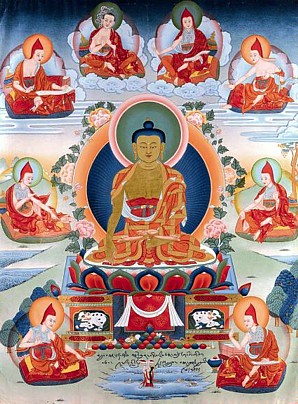「Tengyur 丹珠爾(藏文大藏經之「論疏部」)」修訂間的差異
跳至導覽
跳至搜尋

SSTC Bubble(對話 | 貢獻) 小 (已匯入 1 筆修訂) |
SSTC Serena(對話 | 貢獻) 小 (SSTC Serena 已移動頁面 Tengyur 丹珠爾 至 Tengyur 丹珠爾(藏文大藏經之「論疏部」)) |
| (未顯示同一使用者於中間所作的 2 次修訂) | |
(無差異)
| |
於 2021年3月28日 (日) 22:22 的最新修訂

Buddha with the Six Ornaments and Two Supreme Ones
Tengyur (Wyl. bstan 'gyur) – the commentaries on the teachings of the Buddha. The Tibetan Buddhist Canon is divided into the actual words of the Buddha contained in the Kangyur, and the treatises composed by the learned and accomplished masters of India, which are contained in the Tengyur.
Ringu Tulku Rinpoche has said:
- "All the teachings in Buddhism are divided into two types: the direct teaching of the Buddha and the commentaries. The teachings that come directly from the Buddha are called sutras in Sanskrit and Kangyur in Tibetan. You might call them the scriptural or canonical teachings. The commentaries are called shastras in Sanskrit and tenchö in Tibetan. In Tibetan, this Kangyur is 108 volumes, and the Tengyur, the translation of the commentaries that come from India, is 228 volumes. The commentaries written later on by Tibetans and others can also be called tenchö."